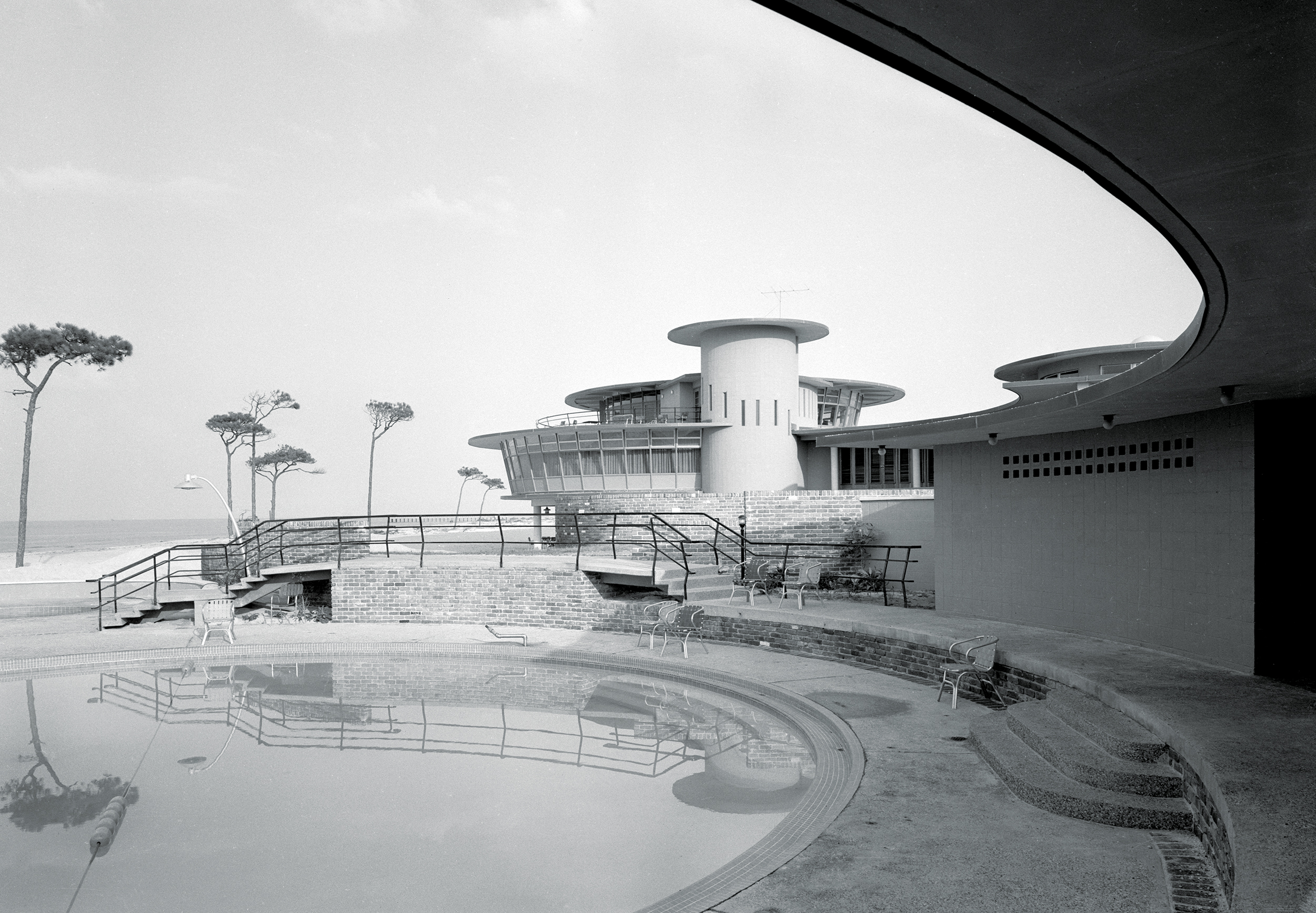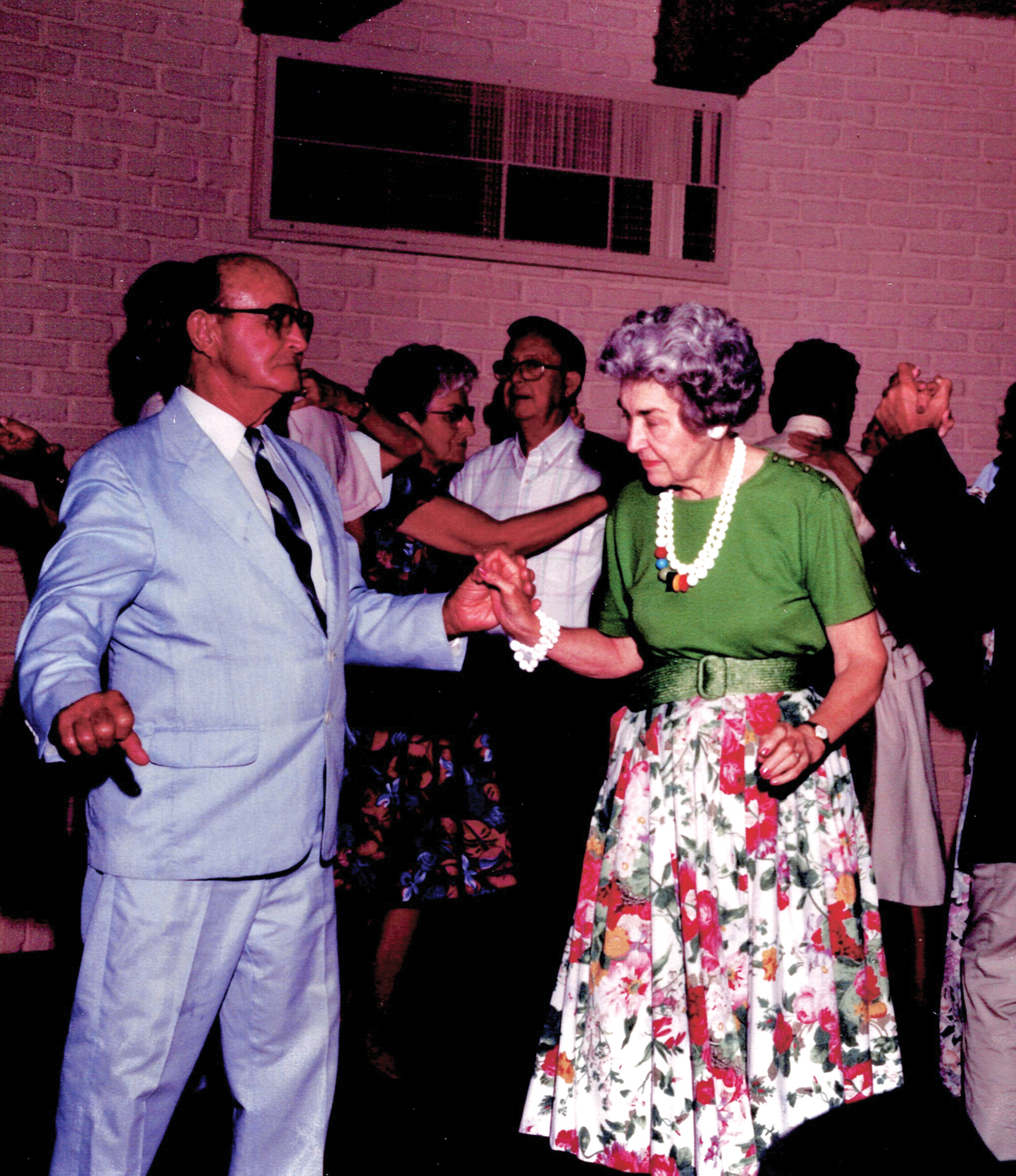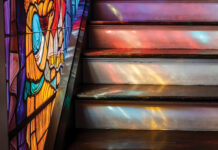
Dressed in her pinafore and bobby socks, young Mia Burmeister stood alongside her father, Carl, her tiny toddler fingers curled around the palm of his ink-stained hand. Her gaze followed his to a giant pile of red dirt heaped upon the gently rolling dunes of powder-soft Dauphin Island sand. He nodded with a grin, his eyes shimmering like the Gulf waters beyond. At the time, Mia recalls, she was unaware of the magnitude of the moment. Not quite 3 years old yet, she couldn’t comprehend what was so special about that little plot by the sea and what it was to become someday.
Today, nearly 70 years later, Mia says she now realizes what her earliest memory meant to her father, and she is thankful that it is so vividly ingrained in her mind. As one of the architects of the legendary Isle Dauphine Club, Carl Freeman Burmeister Jr. envisioned what that dirt pile at 100 Orleans Drive was to become — an avantgarde space for generations of families to relax and connect with one another, to connect with the idyllic barrier island that it would grace. He and the other two architects for the project, Arch Reese Winter and Thomas Howard Ellis, would create all of that in the unforgettable, mid-century modern design that they painstakingly etched into that shoreline. “I understand now that he was just so proud of it,” Mia says. “He wanted to share that with me.”

A Design for the Ages
In true mid-century-modern style of the 1950s, the architectural team utilized bold, geometric shapes — concentric circles and sleek lines — to create a unique three-story structure indicative of the time period and functional for members to easily flow from indoors to outdoors to appreciate the natural scenery. For the color palette, they chose bold yet earthy hues pulled directly from the Gulf waters and sand environment surrounding it. In fact, the original paint colors were inspired by the island’s statuesque magazines at Fort Gaines; bold, coral sunsets on the West End; and, naturally, the beloved Dauphin Island sand. “They even took a handful of sand to the painter and requested a custom color to match so that it would blend into the landscape,” Mia laughs.
With the arrival of the 1960s, laid-back California beach culture rode in on a wave across America. Sandra Dee graced television screens as beach bunny, Gidget, and the Beach Boys made regular appearances on American Bandstand with hits like “Surfin’ U.S.A.” and “Surfer Girl.” Those same good vibrations were alive and well on the Alabama coast, too. Those cultural trends coupled with increased marketing to promote Dauphin Island as a vacation destination contributed to the instant popularity of the Isle Dauphine. After two years of construction, the pride of Dauphin Island opened in 1957. Together, the property and building were valued at nearly $1 million.
Property owners were automatically granted membership at the Club, so Carl and his wife, Mozelle, would bring little Mia and her younger sister, Michelle, to spend the day. Mia fondly remembers splashing around in the little baby pool more than a time or two with her sister. “I still have the little beach bag with the suntan lotion logo that I carried as a little girl when I went there.” On occasion, the family would also make the trip over the bridge after church on Sundays to have a special dinner at the Isle Dauphine’s restaurant.
Inside the glossy, new cylindrical structure, streamlined orange upholstered furniture welcomed grownups to sit, while little ones clambered for a peek at the giant state-of-the-art aquarium, which was built into one of the curved brick walls. The upstairs dining room, otherwise known as the “wheel room,” due to its circular shape and overhead beams mimicking the spokes of a ship’s wheel, featured a wall of windows with panoramic Gulf views, as well as a walkout balcony.

Good People and Good Times
Longtime property owner Ann Tiffin Hays Greer Cowden, now 93 years young, was also there from the very beginning. When the Isle Dauphine’s doors opened, Ann Tiffin says, it was the barrier island’s crown jewel. “It was just exquisite. It had a beautiful, elegant concept, with that great view. It was the place for Mobilians to be — truly a landmark.”
Ann Tiffin and her husband, Mac, were so enamored with the island lifestyle that they built their own home there in 1959. She calls Dauphin Island the love of her life, just as it was for her father, Bob Hays. The longtime “skipper” for the Mobile Chamber of Commerce, Hays had been instrumental in advocating for construction of a bridge to Dauphin Island, which was completed in 1955. “Daddy gave his life to that bridge. He was a real humdinger.” He’d also advocated for the island’s land development, with projects such as the Isle Dauphine. Given his dedication and that he owned Island property, it was only natural that his daughter would find her own happy place there, enjoying the fruits of his labor. (And occasionally those fruits may have wound up in a Sunset Punch tiki cocktail or two.)
Ann Tiffin fondly remembers many long, happy, sun-drenched days spent at the Isle Dauphine throughout the 1960s. Although her husband, Mac, was often stuck back in Mobile working for the family grocery business, Ann Tiffin and their daughter, Vidmer Greer, stayed down at the Island as much as possible, finding reprieve from the blistering Lower Alabama sunshine in the Club’s cool, blue chlorinated pool. She fondly recalls the lifeguards teaching her daughter to swim, and the Greer girls found a tight-knit community with a crowd of other mothers and children.
Like so many others after them, their time there was marked by quintessential summertime fun at the little oasis: endless games of Marco Polo, spirited cannonball contests off the diving board and sunbathing on the pool deck in the teal-blue jelly-tube chaise lounges. “I just loved the people there. And swimming was safer for the kids there than out on the beach.” She adds, “Even though I had an only child, she was never the only child.” Mother and daughter would spend a week at a time on the Island, often bringing friends along for the fun until September when it was time to get back to Mobile to gather school supplies. “We didn’t even have a telephone there, and we liked it that way. I’d tell my husband, ‘You’ll never take me anywhere else.’”

Teen Beach Memories
Jeannette Tabb, 83, fondly recalls her own childhood at her parents’ Dauphin Island vacation home, “All Shook Up.” One of her favorite parts of Island life was hanging out at the Club as a teenager. Chevy Bel Airs graced the parking lots, and music by Elvis, Fats Domino, the Everly Brothers and Lawrence Welk blared over the radio. “There was a little snack bar down by the pool, where we would order food and drinks.” But if they wanted to take it down to the beach for a picnic, shoes were a must. “The walk down to the water was pretty long at the time, and sand spurs were numerous.”
By 1962, the Club expanded, opening a waterfront golf course and clubhouse, eventually followed by tennis courts as well. But even though the outdoor vibe was laid-back, the Club wasn’t just a place for swimsuits and sneakers. “It was always a treat to get to have a nice dinner in the Club’s formal dining room,” says Jeannette. The atmosphere, paired with a stellar upscale menu and excellent service, made it the place to go in Mobile County to celebrate a special night out or for families to gather after church on Sundays.
Jeannette recalls celebrating both her 16th birthday and her high school graduation luncheon there. When folks went to the Isle Dauphine, everyone dressed up. Young ladies wore their fancy dresses, high heels and even cute hats. While the girls ordered Shirley Temples, the adults enjoyed crème de menthe grasshoppers.
Guests often dined on steaks, oysters, shrimp and the restaurant’s signature Crabmeat Caroline, a rich, traditional seafood au gratin. But it was the restaurant’s homemade desserts that Jeannette remembers best. The Club was also known for their creamy Isle Dauphine Pie. “All the desserts were just so elegant and delectable. I’ll never forget I had my first baked Alaska there on my 16th birthday.”


RIGHT: Nikki Dunnavant takes a break from swimming to eat a poolside lunch from the snack bar.
Building the Next Generation
Although Dauphin Island native, Prissy Pryor Hawkins, was not a member of the Isle Dauphine growing up, she frequently visited as a guest with friends in the 1970s and ’80s. She would often play a match of tennis after school or hang out on the Club’s one-mile stretch of sand down at the shore. “When we were in college, we’d get the servers to bring us strawberry daiquiris down to the beach to sip while we tanned.”
Later, Prissy took a job at the Club, first working in accounts receivable and later promoted to manager for the restaurant and event space. The Isle Dauphine continued to be a popular spot for wedding receptions, including Prissy’s own. She laughs as she recalls one of her most unique event requests from another bride: a wedding cake made entirely of potato salad. “Apparently, it was a family tradition.” Once she had daughters, they, too, spent much of their early years toddling around the Club. The staff was like a family, and Prissy loved getting to see and serve the regulars, like the Tuesday morning bridge club ladies. Like clockwork, at 10:15 a.m., it was time to start getting their bloody marys ready.
During Prissy’s time at the helm, the Isle Dauphine hosted monthly events to boost community involvement. One such event was a dinner theater directed by none other than New York City Ballet principal dancer, Ruth Martin, who had retired on the Island. Other months, there were cocktail parties on the veranda or dances up in the Wheel Room with locally famous musicians, such as Bob Schultz, Michael Garlo and Hank Becker, playing live music, just as others had in the early days. By far, the biggest event each year, though, was the annual Board of Realtors party. “There were consistently 5,000 – 7,000 people in attendance.”
Unfortunately, in more recent decades, the Isle Dauphine has fallen on hard times. Damage from multiple hurricanes, the Deepwater Horizon Oil Spill and lack of funding forced the Isle Dauphine to shutter its doors in September of 2012. However, a few years later, the old gal saw a resurgence, with some restoration thanks to the Dauphin Island Property Owners Association and the owners of Pirate’s Bar and Grill, who opted to lease the space for their own beachside restaurant in 2015. Today, guests can still pay to park in the old shell gravel parking lot to access the pool, beach, golf course and other amenities or dine overlooking the Gulf. As Jeannette reminisces, she adds, “It sure would be nice if it could be renovated to be the masterpiece it once was.”
Despite its age spots though, in many ways, the Isle Dauphine is still accomplishing the dreams that Carl Burmeister and his team had imagined, even 67 years later. Along with historians John Sledge, Stephen McNair and others, Mia was one of the principal locals who fought to get this one-of-a-kind gem protected on the National Register of Historic Places in 2017. “It is quite the honor to have it among all of the historic places around the country. I hope the island finds a way to take good advantage of that and show it off in the best light possible — and that the Islanders appreciate what a true gem they have.” Because to preserve the Isle Dauphine is to save a treasured Dauphin Island tradition. A past time and culture. The Isle Dauphine was a place so unforgettable, so beloved, that it held special meaning to Carl, even from its sand dune beginnings. Just as it has for Mia, Ann Tiffin, Jeannette, Prissy and countless other locals and visitors alike for generations after.
Though her paint may be chipped and her sidewalks uneven, the legendary retro building perched upon that Dauphin Island shore lives on — giving off good vibrations to anyone who stops to notice her.
Isle Dauphine Club Pie
This recipe originally appeared in the old Island Bill of Fare cookbook, courtesy of Kay Blacksher.
MAKES 1 9-INCH PIE
1 9-inch pie dough round
1 cup light brown sugar
1/4 cup flour
2 cups coffee cream (half-and-half)
1 teaspoon vanilla
2 ounces butter, softened
Dash of nutmeg
Whipped cream or Cool Whip for serving
1. Preheat oven to 325 degrees. Line a 9-inch pie pan with dough.
2. Combine the brown sugar and flour and cover the bottom of the pie. In a small bowl, combine the coffee cream and vanilla. Pour mixture over top.
3. Add the softened butter in small pieces and sprinkle a dash of nutmeg over top.
4. Bake for about 1 hour and 20 minutes or until the crust is brown and the filling is firm. Note that it gets firmer as it cools.
5. Once cooled, cut into slices. Serve lukewarm with a dollop of whipped cream or CoolWhip.





